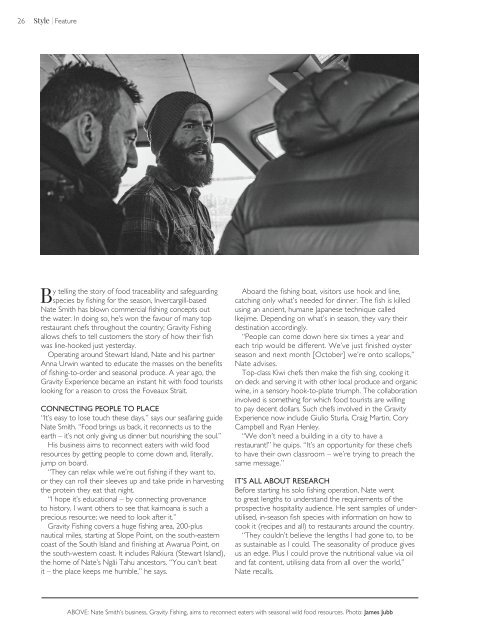You also want an ePaper? Increase the reach of your titles
YUMPU automatically turns print PDFs into web optimized ePapers that Google loves.
26 <strong>Style</strong> | Feature<br />
By telling the story of food traceability and safeguarding<br />
species by fishing for the season, Invercargill-based<br />
Nate Smith has blown commercial fishing concepts out<br />
the water. In doing so, he’s won the favour of many top<br />
restaurant chefs throughout the country; Gravity Fishing<br />
allows chefs to tell customers the story of how their fish<br />
was line-hooked just yesterday.<br />
Operating around Stewart Island, Nate and his partner<br />
Anna Urwin wanted to educate the masses on the benefits<br />
of fishing-to-order and seasonal produce. A year ago, the<br />
Gravity Experience became an instant hit with food tourists<br />
looking for a reason to cross the Foveaux Strait.<br />
CONNECTING PEOPLE TO PLACE<br />
“It’s easy to lose touch these days,” says our seafaring guide<br />
Nate Smith. “Food brings us back, it reconnects us to the<br />
earth – it’s not only giving us dinner but nourishing the soul.”<br />
His business aims to reconnect eaters with wild food<br />
resources by getting people to come down and, literally,<br />
jump on board.<br />
“They can relax while we’re out fishing if they want to,<br />
or they can roll their sleeves up and take pride in harvesting<br />
the protein they eat that night.<br />
“I hope it’s educational – by connecting provenance<br />
to history, I want others to see that kaimoana is such a<br />
precious resource; we need to look after it.”<br />
Gravity Fishing covers a huge fishing area, 200-plus<br />
nautical miles, starting at Slope Point, on the south-eastern<br />
coast of the South Island and finishing at Awarua Point, on<br />
the south-western coast. It includes Rakiura (Stewart Island),<br />
the home of Nate’s Ngāi Tahu ancestors. “You can’t beat<br />
it – the place keeps me humble,” he says.<br />
Aboard the fishing boat, visitors use hook and line,<br />
catching only what’s needed for dinner. The fish is killed<br />
using an ancient, humane Japanese technique called<br />
Ikejime. Depending on what’s in season, they vary their<br />
destination accordingly.<br />
“People can come down here six times a year and<br />
each trip would be different. We’ve just finished oyster<br />
season and next month [<strong>October</strong>] we’re onto scallops,”<br />
Nate advises.<br />
Top-class Kiwi chefs then make the fish sing, cooking it<br />
on deck and serving it with other local produce and organic<br />
wine, in a sensory hook-to-plate triumph. The collaboration<br />
involved is something for which food tourists are willing<br />
to pay decent dollars. Such chefs involved in the Gravity<br />
Experience now include Giulio Sturla, Craig Martin, Cory<br />
Campbell and Ryan Henley.<br />
“We don’t need a building in a city to have a<br />
restaurant!” he quips. “It’s an opportunity for these chefs<br />
to have their own classroom – we’re trying to preach the<br />
same message.”<br />
IT’S ALL ABOUT RESEARCH<br />
Before starting his solo fishing operation, Nate went<br />
to great lengths to understand the requirements of the<br />
prospective hospitality audience. He sent samples of underutilised,<br />
in-season fish species with information on how to<br />
cook it (recipes and all) to restaurants around the country.<br />
“They couldn’t believe the lengths I had gone to, to be<br />
as sustainable as I could. The seasonality of produce gives<br />
us an edge. Plus I could prove the nutritional value via oil<br />
and fat content, utilising data from all over the world,”<br />
Nate recalls.<br />
ABOVE: Nate Smith’s business, Gravity Fishing, aims to reconnect eaters with seasonal wild food resources. Photo: James Jubb


















